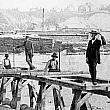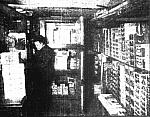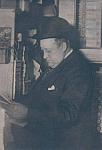Brief History of the Grand Rapids Steam Heating Operation
On May 1, 1888, Grand Rapids in partnership with Thomas Edison formed the Grand Rapids Edison Light and Fuel Co. and began operation at the SW corner of W. Fulton and Ottawa. The plant was attractive in appearance, having been designed by the Edison Light Co. The floors were of polished hardwood and the walls and 16 foot ceiling were of matched white pine with natural finish. The coal fed boilers, four in number, were tubular and rated at 150 H.P. each at 80 pounds pressure. In the engine and dynamo room were three Taylor Beck high speed, non-condensing engines each belted to a pair of Edison 125 volt direct current generators. During the time period, the Fulton St. Plant provided energy to the city’s trolley cars, incandescent street lighting and helped support the rapid growth of the furniture industry.
In 1897 the first heating mains were installed in a new building next door at the SE corner of W. Fulton and Market. The steam was turned on October 15, 1897. The Grand Rapids Heating Plant still occupies the site. By 1910-1911 a report in the Common Council minutes reported that 39 plants were using steam heat from Central Station.
Contrary to myth there are no steam tunnels beneath the city of Grand Rapids with the exception of the very early tunnel beneath the Union Station, which no longer exists, that housed the steam pipes from the Grand Rapids Heating Plant. Click on the image for a larger view.
Consumers Energy Co. acquired the operation in 1915. In 1923 the plant was rebuilt in two sections, boiler room and turbine room. During 1922 through 1927 the steam distribution system was expanded into the downtown area. These new steam mains replaced all existing steam mains installed prior to 1916. Originally low-pressure pipes were located under streets, but newer installations are placed under sidewalks as they are cheaper and easier to access than digging up the street.
Substations, which are very large vaults, were added ca 1965. One is located at the Morton House, another on Weston St. between Division and Commerce. In 1964-65, at the time of urban renewal, the old boilers were retired and replace with three 100,000 pound-per-hour gas/oil fired boilers. New 125 pound steam mains were constructed to serve new building in the lower Monroe St. area and Butterworth Hospital In 1970, the fourth boiler, a 150,000 pound-per-hour gas/oil fired boiler was installed, and a 125 pound steam main to serve St. Mary’s/Mary Free Bed Hospital complex.
Kent County purchased the District Heating and Cooling Operations (DHCO) from Consumers Energy in May of 1986, however Consumers Energy stayed on to operate, maintain and financially manage the operation on behalf of the County Department of Public Works.
The DHCO served 131 customers in downtown Grand Rapids (Feb. 2007). Customer uses for steam include space heating, laundry, culinary use, humidification, domestic hot water and snow melt. Several customers also have steam absorption chillers for cooling.
The steam distribution system consists of approximately 7 miles of underground pipe, 5 miles of underground distribution pipe in the high-pressure system and approximately 2 miles in the low-pressure system, and all repairs, additions and customer operations were controlled directly by the Kent County Dept. of Public Works. High Pressure pipes are 2” in diameter; low pressure pipes from 8” – 22”. The system consists of two separate and independent distribution pressures. The high-pressure system is nominally operated at 120 psig and is monitored at the Fulton Steam Plant through local gauges and one remote gauge located at St. Mary’s Hospital (back to the steam plant) that is at the remote end of the system. The low-pressure system is nominally operated at 6.5 psig and also has a remote gauge at the Peninsula Club building. Both the high and low-pressure distribution systems are 100 percent makeup with no condensate return to the Fulton Steam Plant.
Customers consist of banks, hospitals, hotels, office buildings, condominiums, museums, churches, and miscellaneous small shops, all of which have eliminated the need for in-house boiler and domestic water heating systems.
Saint Mary’s Hospital is the largest single customer, however, the City of Grand Rapids is the largest customer in aggregate with a total of 15 building on the system. Other major buildings include the Public Museum, City Hall, Federal Building, State Building, County Courthouse, Amway Grand Plaza, Plaza Towers, Grand Rapids Press, Bank One, VAI, DeVos Convention Center, Downtown Parking Ramps, VanAndel Arena and the Monroe Mall snow melt systems.
The advantages to the steam system, especially for older buildings undergoing restoration:
- No boilers needed
- Lower insurance costs when no boiler is located in the building
- Provides more usable space without large boilers
- Spares the expense of an engineer
1915
Consumers acquires plant
1922-1924
Plant rebuilt
Jan. 23, 1924
Consumers Power Co. opens its coal-fired boiler plant to supply three miles of low-pressure steam lines.
1960-1970
Consumers installs high-pressure steam lines, expanding the loop to seven miles.
1986
Consumers sells the system to Kent County’s Dept. of Public Works. Consumers Power was under financial stress at the time due to the conversion of the Midland, MI nuclear power plant.
1990
Covanta Kent Inc. takes over plant operation along with the Kent County’s Waste-to-Energy Plant
2006
Divested plant, Veolia Energy began operating the underground steam system
Many thanks to Bill Allen, Waste to Energy Division Director, Kent County Board of Public Works for generously sharing his knowledge about the history and operation of the Grand Rapids Steam Plant.

 facebook
facebook






